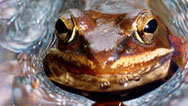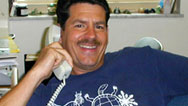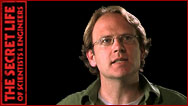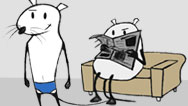Frozen Frogs
- Posted 04.01.05
- NOVA scienceNOW
(This video is no longer available for streaming.) Wood frogs freeze solid in winter then thaw back to life and mate in the spring. How do they do it? Scientists have now figured out how to recreate this extraordinary process of cryopreservation with mammalian organs. To date they have successfully frozen, thawed, and transplanted rat livers and pig hearts. Their dream? Enhanced preservation of human organs for transplant.
Transcript
FROZEN FROGS
PBS Airdate: April 1, 2005
ROBERT KRULWICH: Well, as we all know, it is finally springtime. So before we go, I wanted to celebrate the season. And I can think of no better way than to introduce you to a creature who is, again, very, very small, and lives down here somewhere, close to the ground, doing things that I think you will find very surprising.
Here's the thing about North American wood frogs. They're small...
JOHN COSTANZO: So it might be difficult to spot a frog.
ROBERT KRULWICH: ...very small. But they're everywhere, just out of view, hiding on the forest floor.
JOHN COSTANZO: He's camouflaged. His coloration is the same as the soil around him. You see him here? He's cold.
ROBERT KRULWICH: You can find them here in southern Ohio, all the way up to the Arctic Circle. But, wherever they are, once it gets cold, with the first sprinkle of ice, this frog does something I didn't know was possible. As soon as the frog touches, just touches, an ice crystal...
JOHN COSTANZO: This animal is going to freeze.
ROBERT KRULWICH: Freeze, freeze?
JOHN COSTANZO: Freeze solid, freeze.
ROBERT KRULWICH: That touch of ice immediately sets off signals inside the frog, says Professor John Costanza, that pull water away from the center of its body. So the frog's internal organs are now wrapped in a puddle of water that then turns to solid ice.
JOHN COSTANZO: I still can't get over it. It's really an amazing, amazing thing.
ROBERT KRULWICH: There is no breathing, no kidney function, the heart stops.
JOHN COSTANZO: And there will be no heartbeat for a long period of time.
ROBERT KRULWICH: You mean as in no heartbeat? Nothing?
JOHN COSTANZO: Right. Flat line.
ROBERT KRULWICH: Flatline. For an hour or two?
JOHN COSTANZO: It could be for days, perhaps even weeks.
ROBERT KRULWICH: Really? Sounds like it's virtually dead, no?
JOHN COSTANZO: We know that the frog isn't dead, but he's probably about as close as you can get.
ROBERT KRULWICH: To being dead?
JOHN COSTANZO: Yes.
ROBERT KRULWICH: So, from the outside, this little frog feels like a rock except that as it froze, the frog flooded itself with a kind of sugar.
JOHN COSTANZO: The frog's blood sugar is distributed through the circulatory system and works like an antifreeze.
ROBERT KRULWICH: It's harder for water to freeze, so cells stay just damp enough for the animal to hold itself together, until the springtime, when the days grow a little longer and the ground gets a little warmer and then, well, a kind of miracle happens.
After weeks or months of no heartbeat, none, suddenly there's a pulse. And that first heartbeat leads to another and then another and then, within a day, and—in the case of this little frog, it took about 10 hours—the animal literally comes back to life.
JOHN COSTANZO: Spontaneous resumption of function.
ROBERT KRULWICH: Why?
JOHN COSTANZO: We don't know. We don't know what triggers that event.
ROBERT KRULWICH: And think how elegant a business this is, because although the sun is warming up the outside of this little guy, somehow his insides, his heart, his brain, they thaw first. His insides warm up before his outsides. But somehow, it all happens in perfect synchrony every spring.
JOHN COSTANZO: Yes, and it's going to undertake a very energetic activity. It's mating time.
ROBERT KRULWICH: Oh, you mean hours after it thaws it's going to do it with a lady?
JOHN COSTANZO: It's going to perform.
ROBERT KRULWICH: Uh-huh. What an animal!
JOHN COSTANZO: Can we say that on TV?
ROBERT KRULWICH: I don't know if we can or not.
Well, we just did.
Credits
Frozen Frogs
- Produced and Edited by
- Vincent Liota & Win Rosenfeld
NOVA scienceNOW
- Executive Producer
- Samuel Fine
- Executive Editor
- Robert Krulwich
- Senior Series Producer
- Vincent Liota
- Supervising Producer
- Andrea Cross
- Development Producer
- Kyla Dunn
- Associate Producer
- Win Rosenfeld
- Program Editor
- David Small
- Unit Manager
- Candace White
- Researcher
- Jason Spingarn-Koff
- Production Secretary
- Hong Jung
- Music
- Rob Morsberger
- NOVA scienceNOW Series Animation
- Edgeworx
- Associate Producers
- Anthony Manupelli
Mary Robertson
Cass Sapir
Ben Sweeney - Camera
- Nate Clapp
Brian Dowley
Allen Facemire
Ken Fuhr
Bob Hanna
Jack Rayzor
Jon Tichota
Joe Vitagliano
Brett Wiley
Ken Willanger - Sound Recordists
- Bob Bryan
Walter James
Anthony Rowland
Jayme Roy
George Schafnacker
Jimmy Williams
Andrew Yuncza - Audio Mix
- John Jenkins
- Animation
- Pie Design
- Additional Production by
- Simon Nasht
Annamaria Talas - Additional Music
- Mark De Gli Antoni
- Production Assistant
- Robbie Gemmel
- Compositing
- Yunsik Noh
- Special Thanks
- American Museum of Natural History
Jade Boyd
Florida State University
R. Thomas Hammond
Ann Kiessling
David Scadden - Special thanks for its decade of support for NOVA to the
- Park Foundation
- Howard Hughes Medical Institute Investigators
- Doug Melton
Leonard Zon - Archival Material
- ABCNEWS VideoSource
Rainer Albiez
Avalanche, Inc.
BBC Motion Gallery
Dr. Tony Brain & David Parker / Photo Researchers, Inc
Corbis Corporation
The Field Museum of Chicago
Gillian Darling
Susan A. Levine Photographic Art
Lubbock Metro
National Geographic Film Library
Dr. Yorgus Nikas/Photo Researchers Inc.
Bill Nipper
Paprikaas Animation Studios - Les Films D'ici, France
Popular Science
Small Times Media
Ultimate Ungulate Images - NOVA Series Graphics
- yU + co.
- NOVA Theme MUSIC
- Walter
Werzowa
John Luker
Musikvergnuegen, Inc. - Additional NOVA Theme Music
- Ray Loring
- Post Production Online Editor
- Spencer Gentry
- Closed Captioning
- The Caption Center
- NOVA Administrator
- Dara Bourne
- Publicity
- Jonathan
Renes
Diane Buxton
Olivia Wong - Senior Researcher
- Barbara Moran
- Production Coordinator
- Linda Callahan
- Unit Manager
- Lola Norman-Salako
- Legal Counsel
- Susan Rosen Shishko
- Post Production Assistant
- Patrick Carey
- Associate Producer, Post Production
- Nathan Gunner
- Post Production Supervisor
- Regina O'Toole
- Post Production Editor
- Rebecca Nieto
- Post Production Manager
- Maureen Barden Lynch
- Supervising Producer
- Stephen Sweigart
- Producer, Special Projects
- Susanne Simpson
- Coordinating Producer
- Laurie Cahalane
- Senior Science Editor
- Evan Hadingham
- Senior Series Producer
- Melanie Wallace
- Managing Director
- Alan Ritsko
- Senior Executive Producer
- Paula S. Apsell
NOVA scienceNOW is a trademark of the WGBH Educational Foundation
This material is based upon work supported by the National Science Foundation under Grant No. 0229297. Any opinions, findings, and conclusions or recommendations expressed in this material are those of the author(s) and do not necessarily reflect the views of the National Science Foundation.
© 2005 WGBH Educational Foundation
All rights reserved
- Image credit: (wood frog) © Stephen Maka Photography
Related Links
-

Cold Cures
The inner workings of frozen frogs offer insight into the medical uses of extreme cold.
-

Frozen Frogs: Expert Q&A
Miami University researcher Jon Costanzo answers questions about reptile and amphibian cryobiology.
-

The Secret Life of Mark Siddall
Meet Mark Siddall, a leech expert and chef of exotic food.
-

Marathon Mouse
With an "exercise pill," researchers turn couch-potato rodents into champion runners.
-

Fish Surgery
Pet owners are turning to veterinary medicine for costly treatments of their goldfish, koi, and other fish.
-

Frozen Frogs
Discover how the wood frog freezes solid every winter, an adaptation that allows the organism to survive the season.



